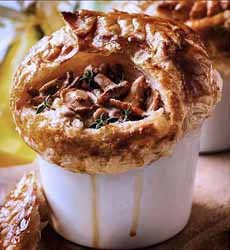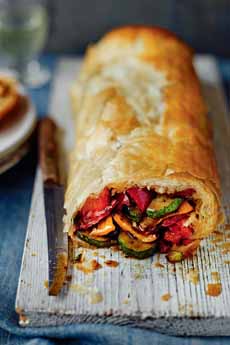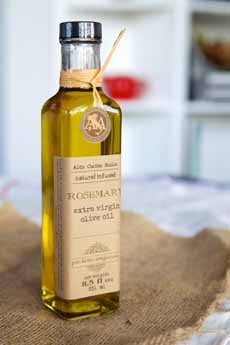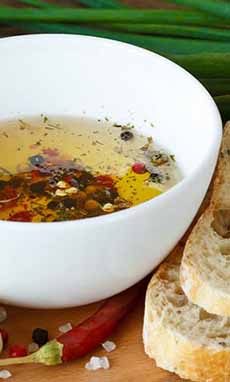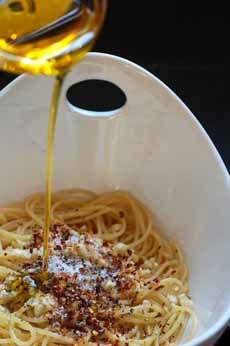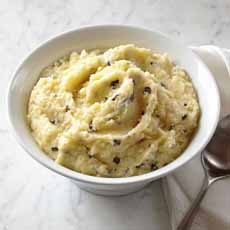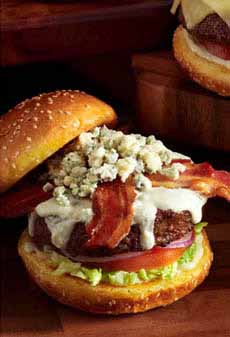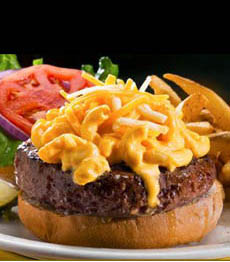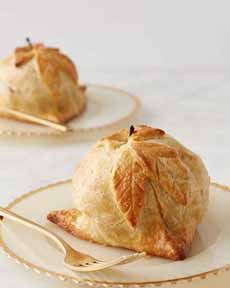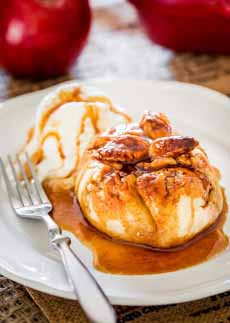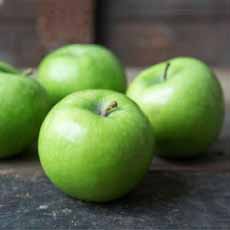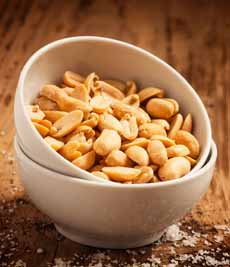|
Chef Jamie Oliver calls the recipe below (photo #1) a picnic pie, because it’s so easy to transport and serve at picnics or other outdoor events.
Picnic season may be just past, but this recipe uses ingredients that are available year-round.
With the popularity of chicken pot pie in the U.S.,
MEAT PIE HISTORY
Meat “pie” has been made since man first used a wrapper to keep in the juices of cooking meat. Evidence dates back to the Neolithic Period, around 9500 B.C.E., but it’s not a pie we would recognize today.
Pastry was perfected by the ancient Egyptians. Their pies were savory pastry: a dough of flour and water paste to wrap around meat and soak up the juices as it cooked (here’s a brief history of pastry).
While our focus today is on vegetables, it’s fun to look at the ancestor of pot pies.
In the days of the Roman Empire, large pot pies served to the wealthy sometimes had live birds under the crust that would burst out flying when the crust was cut [source]. You can see this happen in a banquet scene in Fellini Satyricon.
How the birds remained live under a baked pie crust, and why people would want live birds atop their food, we can only imagine (for the former, we’re guessing that a crust was baked separately and the birds and crust added at the last minute).
While you’d think this decadence would have ended with the Roman Empire, one recipe author in 16th-century England advised how “to make pies that the birds may be alive and fly out when it is cut up….”
But most pies were simpler affairs, involving a pastry crust, meat and gravy. When there was no meat, vegetables were used.
What happened to the meat pie beyond Egypt?
Some sources explain that the ancient Greeks placed cook meats in open pastry shells, and that the Romans added the top crust.
In America, the cookbook American Cookery, published in 1796, included recipes for chicken pot pie, beef pot pie, and “Sea Pie,” which used pigeons, turkey, veal and mutton. The recipe was originally developed aboard ships, which used whatever preserved meats were available [source].
The term “pot pie” is an English term, simply describing how it was made: by molding pastry along the bottom of of pot [source]. Metal pie pans did not appear until the 16th century, and the poor could not afford them.
RECIPE: VEGETABLE PIE
This recipe (photo #1) was adopted from one by Jamie Oliver. Unlike a vegetable pot pie, it is solid layered vegetables, not chopped vegetables in a sauce.
He suggests serving chutney as a condiment, with a chilled rosé to drink.
If you don’t like a particular ingredient, substitute mushrooms or other vegetable. Serve the pie as a main course or a first course.
Ingredients
1 medium butternut squash, peeled and cut into 2″ slices
Salt and pepper to taste
3 sprigs fresh rosemary leaves, stalks discarded
2 large red onions, peeled and sliced
2 eggplants, peeled and sliced
2 zucchini, peeled and sliced lengthwise
Olive oil
3 large red bell peppers
1 tablespoon balsamic vinegar
½ teaspoon raw sugar or light brown sugar
20 ounces baby spinach, washed
8 ounces ricotta cheese
2 lemons, zested
1/4 cup parmesan cheese
Unsalted butter for greasing
Plain flour for dusting
1 recipe shortcrust pastry
1 bunch fresh basil, stems removed
4 ounces soft goat cheese
1 large egg, beaten
Preparation
1. PREHEAT the oven to 400°F. Place the squash on a baking sheet. Season with salt and pepper and drizzle with 3 tablespoons of oil. Roast on the top rack for 25 minutes or until soft. Add the garlic and rosemary after 20 minutes.
2. PLACE the bell peppers on a second baking sheet and place on the lower oven rack for 35 minutes, or until blackened. Place them in a bowl, cover with plastic wrap and set aside for 10 minutes. Then peel, remove the seeds and slice into large pieces (thick rings are fine). Season them and drain in a colander.
3. HEAT 2 tablespoons of oil in a large pan over medium heat and sweat the onions for 10 to 12 minutes, or until just caramelized. Stir in the balsamic and sugar and cook for another 5 minutes.
4. PLACE a griddle or large pan over a medium-high heat. In batches, brush the eggplant and zucchini slices with oil and place on the hot griddle for 5 minutes, until soft and lightly charred. Halfway through, turn and season. When cooked, transfer to a plate and set aside.
5. BOIL a kettle of water. Put the spinach in a colander and pour over the boiling water to wilt it. Let it cool, then squeeze it dry, chop it and place it in a bowl. Add the ricotta to the spinach, the lemon zest and half the parmesan. Season, stir to combine and set aside.
6. REDUCE the oven temperature to 350°F. Grease and flour a 9-inch springform pan.
7. ROLL out 2/3 of the pastry on a floured surface, so it fits the base and sides of the springform. Press it into place, leaving a little overhang; trim off any excess. Sprinkle half the basil and half of the remaining Parmesan over the pastry base, then layer the vegetables.
8. BEGIN with the zucchini and eggplant, followed by a layer of bell peppers, then the spinach. Add over the squash and onions, then dots of the goat cheese. Scatter on the rest of the basil and parmesan.
|


